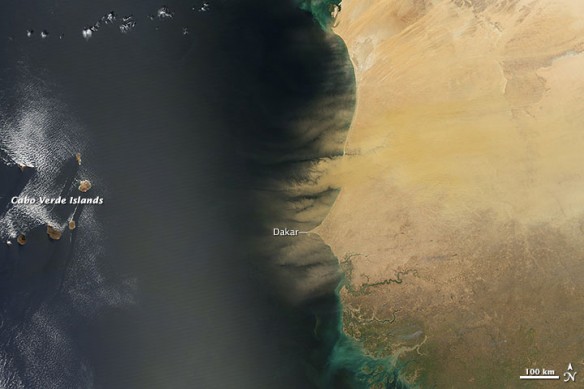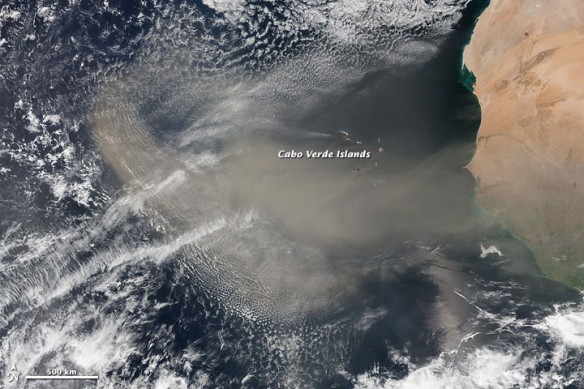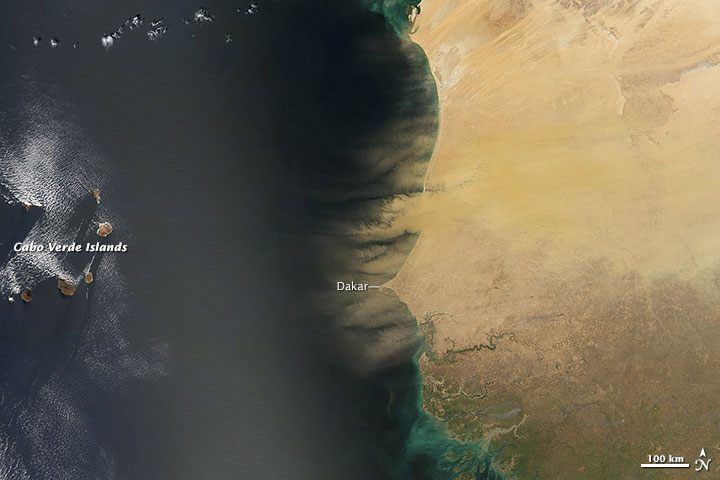
Acquired February 26, 2015; NASA
By Michael Carlowicz and Ellen Gray, NASA / Earth Observatory;
Hundreds of millions of tons of sand and dust particles are lifted from North African deserts each year and carried across the Atlantic Ocean. So much dust is kicked up that the microscopic particles amass into sweeping tan plumes that are visible to satellites.
On February 26, 2015, the Moderate Resolution Imaging Spectroradiometer (MODIS) on NASA’s Aqua satellite observed some of that dust starting a trans-Atlantic journey. In the image above, vast amounts of dust rise up from Senegal, Mauritania, and Gambia. The plumes are thick and brown, suggesting that he dust is still compact and that it probably arose close to the coast—not from a more distant location in the North African interior. Some of the dust also appears to be settling into the waters just offshore, adding to the darkening effect in the satellite view. A bit farther offshore, the water surface is brightened by sunglint, the reflection of sunlight directly back at the camera from a relatively smooth surface.
By the next day, the MODIS instrument on NASA’s Terra satellite observed the dust passing over the Cabo Verde Islands (below). The dust cloud was lighter in color, as the coarser, larger sand grains likely dropped out closer to the African coast. Note how the volcanic islands created wake patterns in the dust, as the rough mountain peaks stuck out from the smooth ocean surface and changed the air flow on the leeward side. Low-level dust was probably deposited on the islands, as well.

Acquired February 27, 2015.
Note also the semi-circular pattern of the clouds to the west, with a region of clear, dry air between the clouds and the dust storm. The pattern was likely caused by air advecting from the North African desert; a front of dry air in a high-pressure weather system prevented cloud formation ahead of the dust.
By the time the Visible Infrared Imaging Radiometer Suite on the Suomi NPP satellite got a look on February 28 (below), the clear, dry air had been overtaken by the dust, which was half-way to South America. Note, too, the faint gray pall of smoke from fires farther down the African coast.

Acquired February 28, 2015.
In a new paper published on February 24, 2015, scientists using a NASA satellite announced that they had quantified in three dimensions how much dust makes the trans-Atlantic journey from the Sahara Desert to South America. Scientists not only measured the volume of dust, but they also calculated how much phosphorus—remnant in Saharan sands from the desert’s ancient past as a lake bed—gets carried from one of the planet’s most desolate places to one of its most fertile. The work by Yu and colleagues appeared in the journal Geophysical Research Letters.
The trans-continental journey of dust is important because of what is often in the dust, said lead author Hongbin Yu, an atmospheric scientist from the University of Maryland who is based at NASA’s Goddard Space Flight Center. Dust picked up from the Bodélé Depression in Chad—farther inland than in the storm shown above—has rock minerals loaded with phosphorus, an essential nutrient for plant proteins and growth. The Amazon rainforest depends on this dust to flourish because soil nutrients are in short supply in Amazonian soils.
Fallen, decomposing leaves and organic matter provide the majority of nutrients in the rainforest, but those nutrients are rapidly absorbed by plants and trees after entering the soil. But some nutrients like phosphorus are washed away by rainfall into streams and rivers, draining from the Amazon basin like a slowly leaking bathtub. The phosphorus that reaches Amazon soils from Saharan dust—an estimated 22,000 tons per year—is about the same amount as that lost from rain and flooding, Yu said.
The new dust transport estimates were derived from data collected from 2007 though 2013 by NASA’s Cloud-Aerosol Lidar and Infrared Pathfinder Satellite Observation, or CALIPSO. The data show that wind and weather pick up on average 182 million tons of dust each year and carry it past the western edge of the Sahara. The dust then travels 1,600 miles across the Atlantic Ocean, though some drops to the surface or is flushed from the sky by rain. Near the eastern coast of South America, 132 million tons remain in the air and 27.7 million tons fall to the surface over the Amazon basin. About 43 million tons of dust travel farther to settle out over the Caribbean Sea.
[youtube]https://www.youtube.com/watch?v=ygulQJoIe2Y[/youtube]
NASA | Satellite Tracks Saharan Dust to Amazon in 3-D









